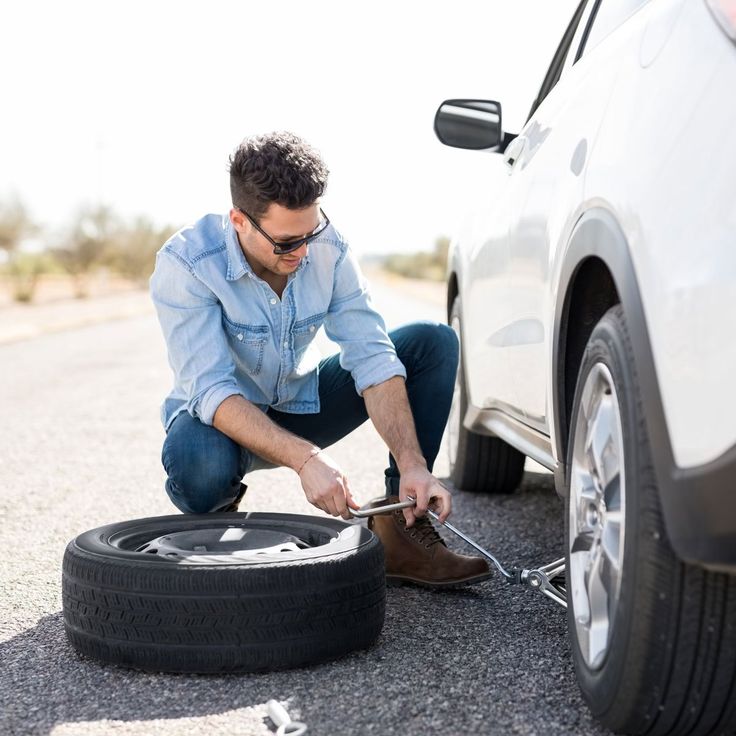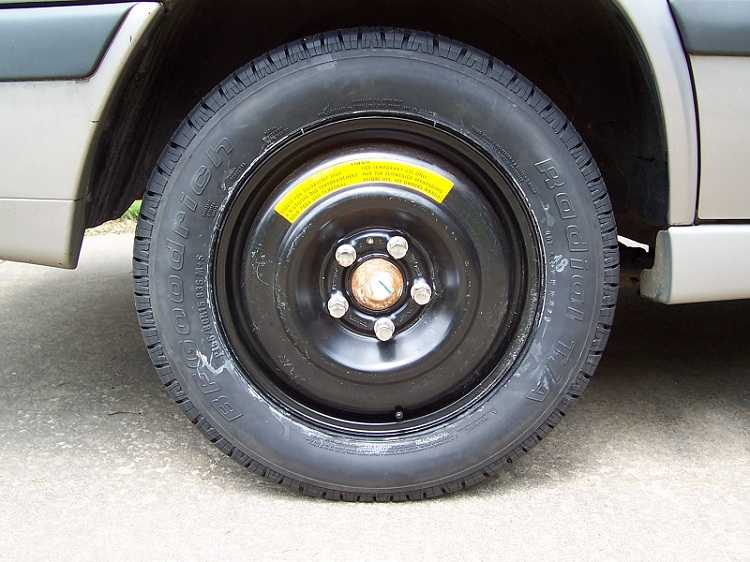Donut tires are probably no longer strange to many people, especially those who drive long distances. With the characteristics of small, compact, and light, this is an optimal choice to save space and replace conventional tires in case of failure.
So, how long does a donut tire last? A regular donut tire can only extend its life to 50-70 miles. Also, you can’t run at speeds above 70 mph with it.
This article will help you better understand how this type of tire works.
Scroll down to read the details!
How Long Does A Donut Tire Last?This tire is only available for about 50-70 miles of driving, and their disadvantage is evident from the external structure. The reinforced rubber layer is thin, so it wears out quickly.
When owning a donut spare tire, in addition to using it for the primary purpose, you need to preserve it to increase its life.
Unlike conventional wheels or tires, the service life is fixed according to the distance traveled. It is evident on the donuts.
People divide the spare tire into two types: small spare and large spare.
For the small one, the type used is quite common, with the required features plus the convenience it brings. Many people consider this the most optimal solution when having problems with ordinary wheels.
The depth of the groove and the tread surface is less, so the grip is not high, so the friction is not much. In addition, when using the above one, experts also recommend not to exceed 50 mph.
Next is the sizable spare version. A spare tire like this is comparable to a regular traveling tire. It is a large size, and both are slightly better than the donut-type backup because of the strength and size. So, this feature also means a longer time to use.
What Happens If You Drive On A Donut Tire Too Long?Damage is a sure thing when you use the donuts for too long. It is not natural that people call donuts a temporary one.
Like the name, the donut is only available for a short time, and it is only a must-have solution in a reluctant situation.
This tire is not suitable for long trips. The sidewall is too thin, causing tire wear to take place quickly, especially when traveling at high speed.
The diameter is not too large, so the contact surface and friction are not high; it is difficult to control the steering wheel when entering the slippery area.
Finally, the grooves are not deep, making it impossible for the wheel to drain all the water to the outside.
Over time, water infiltration can occur at any time, which causes hazardous consequences.
How Many Years Do Donut Tires Last Unused?According to research, new tires last up to 10 years. But if you want to ensure 100% safety, we recommend you not to use them with a term of 6 years or more.
The transformation process still takes place no matter how carefully you preserve them. Oxygen in the air, even mold in nature, destroys the tire every day. Although rubber has antibodies to oxygen, to be honest, it can only slow down the aging process.
Besides, over time, rubber also gradually loses its elasticity and traction, making the quality of the product significantly reduced.
Can I Use A Donut From A Different Car?Of course, the answer is No. Each vehicle will have the size of a different donut.
Although the tires’ appearance is similar, this does not guarantee that they will be suitable for the type of vehicle you are driving.
If you can confirm that all the parameters are the same, it is entirely possible to change the donut tires for each other.
FAQsIf I see anyone intending to use a 20-year-old one, I will discourage them. It is hazardous. Manufacturers have recommended changing tires every six years, and the maximum shelf life is ten years. The worst consequence of using a tire for too long is an accident because then it seems that the textures in the tire are no longer intact. They can be more brittle, fragile, and not resistant to the more heavy load.
For your safety, we still recommend not using the 10-year-old donut tire. You can search for damaged areas due to exposure to chemicals and environmental conditions. It makes the rubber material difficult to have elasticity, making it difficult to move.
50-70 miles is the route that regulates the lifespan of the donut. Unlike the general rules of tires, the donut has a different rating. Because this is a spare one, there may be additional regulations for a few reasons.
Are There Different Types of Spare Tires?There are two main types of spare one:
Large spare version: Strong, flexible construction, large size takes up more space and can be available as regular tires.
Small size spare version: is a small, compact, light-weight temporary version. But only for short travel and cannot be reused.
Personal safety always comes first. Carefully learning the information related to tires partly makes you feel secure during use.
All the information we provide is compiled from reputable knowledge sites to trust it. We hope that you can better understand the related issues through the above knowledge.
If you have any questions, please leave a comment, and we will answer as soon as possible. Thank you for taking the time to read this!
This post was last updated onEditor’s Note: This blog has been updated in 2021 to reflect current industry standards.
In older cars, every model came with a spare tire that matched the tires already on the vehicle. Over the years, car manufacturers have realized the spare tire is used so infrequently, it does not make much sense to equip every car with a full-sized spare. For this reason, manufacturers began leaving a space-saver spare (otherwise known as a donut) in place of a full-size spare.
Nowadays, spare tires should never be a permanent replacement, begging the question, how long can you really drive on a spare tire? The type of spare tire in your vehicle makes a difference in how long and how far you can drive before fixing your tire or buying a new tire.
These narrow, compact spares are designed to save space and weight in the vehicle, allowing the manufacturers to build a smaller car. However, the tire itself is not built to last. Your owner’s manual will give recommendations for driving time and speed. A general rule of thumb is to drive no farther than 70 miles and no faster than 50 miles per hour before replacing your donut with a new tire.
The biggest reason why you should avoid prolonged use of space-saver or donut tires is that they have little to no tread, making the spare vulnerable to road hazards and projectiles. It is also much smaller than the other 3 tires, making it spin faster to keep up with the moving car.
Run-flat tires are becoming more common as manufacturers realize they cost less to maintain than traditional tires. If you drive a recent model BMW or a MINI, your car likely came with run-flat tires. These tires are tougher than most tires but are not designed to last forever, such as a full-spare tire.
Rather than including a spare tire, these run-flat tires are built to withstand most road hazards, including punctures. Rather than going flat or blowing out (as traditional tires do), a run-flat tire can continue to drive after punctured for about 50 miles before needing to be replaced. However, these tires cost more to replace than traditional tires.
While you have a bit more room to travel on these types of tires, it is important to inspect your tire as soon as you are aware of any change in tire pressure. This gives you an idea of how long you have until you have no choice but to have your tire replaced.
This gives you an idea of how long you have until you have no choice but to have your tire replaced.
How Long Can You Drive on a Full-Size Spare Tire?
For years, cars were built with spare tire wells capable of carrying a full-size spare. On many older cars (and a few newer models), this is still the case. If you bought a truck, SUV, or another large vehicle, your car probably is equipped with a full-size spare. While a full-size spare is heavier and requires a larger space for storage, these tires are more durable and can handle a drive similar to a regular tire.
Once you have taken your vehicle to an auto repair shop and learned that the punctured tire is irreparable, you can request the spare tire to be put on the original rim.It is important to note that a full-size spare tire is usually not produced by the same manufacturer as the rest of the tires on your vehicle, meaning it will handle differently than the other tires. We suggest buying a new tire as soon as you can afford to, but this can easily buy you some time.
Christian Brothers Automotive was born out of the idea of not just being an auto repair shop, but also a neighbor. Our mission is simple: to take root in the local communities we serve and to create an uncommonly great experience for customers in need of auto service and repair. To have your tires inspected or to replace a spare tire, please do not hesitate to call or visit your local Christian Brothers Automotive shop. We have 240 plus locations nationwide that are locally owned and operated, providing complete auto care and repair solutions near you.
The spare wheel, at first glance, is no different from the wheels that are installed on cars. But it turns out that not all spare wheels can be used as main wheels for a long time.
Contents
main wheels. In addition, their service life is much lower. Visually similar to the main ones, they differ in structure. The sides are made of rubber with one layer of polyester and just two bands of steel. The protector also consists of a single layer of polyester. Such tires are short-lived and quickly become unusable when driving. We will look at the two main types of spare wheels and their distinctive features.
Often, in factories, car manufacturers are equipped with spare wheels, which in our country are called "donuts" because of their small size and shape. In English-speaking countries, they are called Space Savers, which means "saving space." They fell in love with car owners because of their small size and practicality. They have advantages, but they also have disadvantages.
They have advantages, but they also have disadvantages.
Donut benefits:
Doughnut Disadvantages:
 On average, it is possible to drive 80 km on such a tire. In some cases, on a good road 110 km. This is enough to get to the store or service. The tire is not subject to further use, as it is rubbed to holes.
On average, it is possible to drive 80 km on such a tire. In some cases, on a good road 110 km. This is enough to get to the store or service. The tire is not subject to further use, as it is rubbed to holes.
Some manufacturers provide full-size, durable wheels on vehicles. They are bigger and heavier than donuts, but they can be ridden for just as long as the main wheels. The only exception may be the tread pattern, composition and width of the tire, which may differ from the main wheels. All of these can affect handling. After the driver has installed the spare tire, he must fill the empty space in the trunk with a new one as soon as possible. The problem with the wheel can happen in a year, maybe tomorrow. You must always be ready for this.
You must always be ready for this.
Spare tires are useful insurance, but most are not designed to replace a flat tire indefinitely.
Not all spare wheels are created equal, and to better understand which spare tire your vehicle is equipped with, please refer to your vehicle owner's manual. Temporary spare tires generally do not have the life expectancy that regular tires do. Unlike a normal car tyre, spare tires can only have one polyester ply in the sidewall and two steel belts with a ply of polyester in the tread, meaning they can't provide half the performance and safety that an average tire can provide.
In this article we will try to describe all types of spare wheels available, and tell you how long you can drive on each of them.
These little spare tires are commonly referred to as donuts or space savers. They are very popular because they are lightweight and do not take up much space in the luggage compartment of your car. Due to the low weight, even a person who is not at all predisposed to physical activity will not find it difficult to lift and install such a spare wheel. By the way, how to do it in the field, without the help of specialists, read here.
Due to the low weight, even a person who is not at all predisposed to physical activity will not find it difficult to lift and install such a spare wheel. By the way, how to do it in the field, without the help of specialists, read here.
However, because the "doughnuts " are smaller and lighter, they lack two key features of conventional tires: strength and stability. Most of these spare tires have a speed limit of up to 90 km/h. With such a spare tire, you can expect to cover a distance of 80 km, some of them can cover up to 110 km. This should be enough to find the nearest tire shop and fix the damaged tire, or find a shop where you can buy a brand new tire if the previous one is no longer repairable.
From the above, we can conclude that the donut spare wheel is not recommended for long trips or pulling with its replacement with a normal, standard wheel.
Some car manufacturers fit their vehicles with full size spare tires. They are, of course, heavier than space savers and take up much more space in the trunk, but they are more durable and durable. They are able to last you much longer than donuts. However, these tires may have a different tread pattern or rubber compound than a conventional tire. This can affect overall handling and safety on the road.
They are, of course, heavier than space savers and take up much more space in the trunk, but they are more durable and durable. They are able to last you much longer than donuts. However, these tires may have a different tread pattern or rubber compound than a conventional tire. This can affect overall handling and safety on the road.
Although these tires are more durable, they are primarily designed to get you to your destination before you deal with the tire problem. In addition, do not forget that the place for the spare wheel in the car is empty, and it should be filled as soon as possible before another tire is punctured.
If you do not have a spare tire in your vehicle, then your vehicle may be equipped with run-flat tires. BMW and MINI typically install these tires during production. This type of tire is tougher than other tires and can withstand a puncture and keep going. However, they are also not designed to be ridden forever.